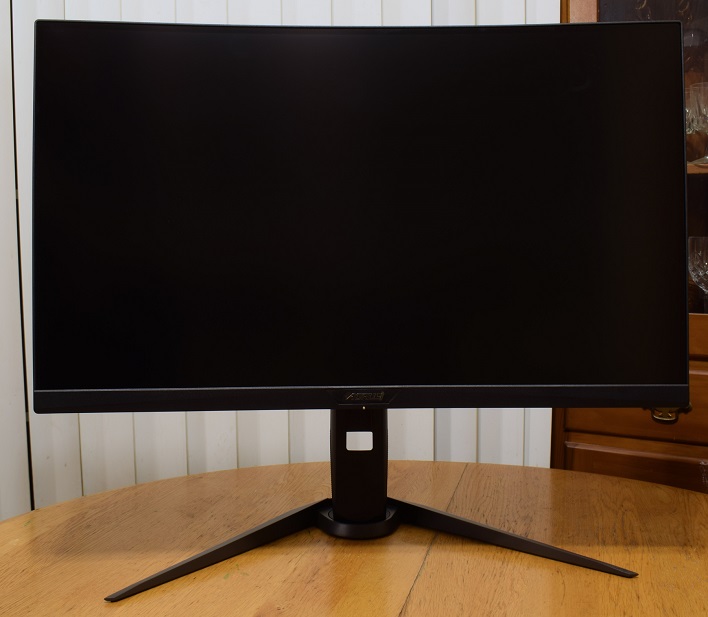Gigabyte Aorus CV27F Monitor Review: 27" Of 165Hz Curved Gaming Bliss
Out of the box the CV27F has a premium feel. Both the stand and base are made of a powder-coated hefty metal, and assembly is a snap. The top and side bezels are relatively small, but there's just enough space at the top for us to comfortably mount our Logitech C525 webcam without overlapping the top few rows of pixels. The bottom bezel is a bit bigger, and has an Aorus logo emblazoned across the center. There's a tiny, low-power LED to indicate when the display is on, though it can be disabled is you don't like the distraction. We didn't feel the need to turn it off, however, since the output is pretty dim.
The mechanism in the CV27F's stand lifts the panel effortlessly without overshooting the desired height. There's enough height adjustment to go around, too—130 millimeters (around 5.1 inches) of lift. There's 25 degrees of tilt and 20 degrees of swivel available, too. If that's not good enough, the CV27F also supports the standard 100 x 100 millimeter VESA mount standard, should you want to use it with an aftermarket arm. We had no problems getting the monitor set to just the right height and angle for playing games. Also inside the box are cables for power, USB, HDMI, and DisplayPort. All of those cables are approximately five feet in length, so if your PC sits on the floor you might need to invest in something longer.
There's a lot more to cover as well. But before we dive in, let's take a look at the panel's specs in detail...
|
| Screen Size |
27-inch |
| Max Resolution |
Full HD (1920 x 1080) |
| Backlight | LED |
| Aspect Ratio |
16:9 |
| Color Support |
16.77 Million Colors |
| Contrast Ratio | 3,000:1 (Maximum) |
| Brightness | 400 cd/m2 |
| HDR Support | Yes (Vesa certified HDR 400) |
| Viewing Angles |
178°(H)/178°(V) |
| Refresh Rate |
165 Hz |
| Response Time |
1ms (MPRT) |
| Panel Type | Vertical Alignment (VA) |
| Variable Refresh | AMD FreeSync 2 HDR, Nvidia G-Sync Compatible |
| Pixel Pitch |
0.311 mm |
| Connectivity |
DisplayPort 1.2 (x1), HDMI 2.0 (x2), USB 3.0 Type-A (x2), 3.5mm Mini Jack (x1), 3.5mm Mic Jack |
| Speakers |
N/A |
| Stand |
Height, Tilt, Swivel, Pivot |
| Accessories | Power, High Speed HDMI, DisplayPort, USB 3.0 cables |
| Dimensions | 14.53 ~ 20.95 (H) x 24.17 (W) x 10.24 (D) inches (369-532 x 614 x 260 mm) |
| Weight |
17.78 lbs (9 kg) |
| Manufacturer Warranty |
3-year limited warranty |
| Price | $399 - Find It At Amazon |
Around the back are some RGB LED accents, which we'll get to in a bit, along with all of the connectivity. The ports face downward, making the CV27F suitable for hanging on a wall, if desired.
On the left is a headphone output and microphone input. The CV27F has a two-microphone active noise cancelling array built in, but you won't record any audio through the display without a dedicated third mic plugged into the pink jack. Next are a pair of HDMI 2.0 ports. You might not think those are necessary since we're not dealing with a 4K panel, but they also provide plenty of bandwidth for very high refresh rates at 1080p. Finally, we have a DisplayPort 1.2 input.
The CV27F also has a two-port USB 3.0 hub built in, which is handy for connecting a keyboard and mouse. The USB 3.0 Type B port connects to the PC via the included cable. Even if you're not using the hub, the USB cable is necessary if you want to use Aorus's OSD Sidekick, the Windows-based app for tweaking all the knobs and switches on the CV27F.
Now let's take a look at how to configure the display, so we can get it ready for calibration and some gaming action.








